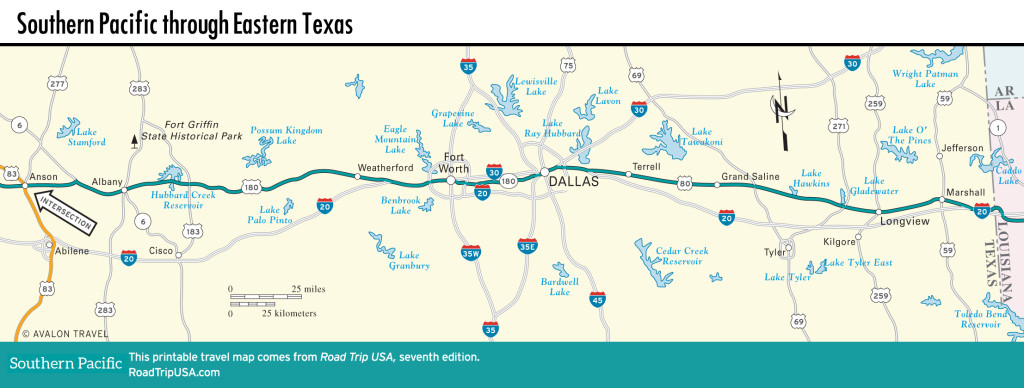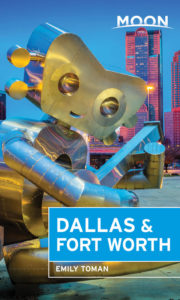Kilgore to Jefferson
Kilgore: Oil!
The pine-covered red-earth hills of East Texas are covered with creaking old pump jacks, still sucking up the crude oil that has kept the region economically afloat since the 1930s. The oil business here has gone through numerous booms and busts since it gushed into existence in December 1930 at a well outside Kilgore (pop. 14,862), on the south side of I-20, about 12 mi (19.3 km) southwest of Longview via US-259. This comparatively small and quiet oil town has street lamps disguised as oil rigs and a set of 100-foot-tall derricks standing along the railroad tracks in memory of the “World’s Richest Acre,” a plot of downtown land that produced over 2.5 million barrels of oil through the 1960s. The site was so productive and so valuable that one of the wells was drilled through the terrazzo floor of a local bank, and over a thousand derricks once loomed over the downtown area.
The history of the local petroleum industry is recounted in entertaining detail at the East Texas Oil Museum (Hwy-259 at Ross St., 903/983-8295, Wed.-Sat., $8) on the campus of Kilgore College, off US-259. The museum includes displays of drilling equipment and old gas stations, plus a simulated “elevator ride” a mile (1.6 km) deep into the earth to show off the oil-bearing geology. Also on the Kilgore College campus, in the Physical Education Complex, is a small free museum devoted to the Kilgore Rangerettes (1100 Broadway, 903/983-8265), a highly trained precision drill and dance cheerleading team that performs at college and professional football games.
Back on US-80, well north of the I-20 freeway, the booming oil-fueled city of Longview (pop. 81,647) holds one of the best places to eat in East Texas. Longview is also where actor Matthew McConaughey went to high school. In between his role in the stoner comedy Dazed and Confused and his Academy Award-winning performance in Dallas Buyers Club, McConaughey appeared in Richard Linklater’s East Texas film Bernie.
Marshall and Jefferson
North of I-20 about 20 mi (32 km) west of the Louisiana state line, Marshall (pop. 23,091) is one of the older towns in Texas, and was once among its wealthiest. Now a fairly quiet place, in its early years Marshall was the commercial capital of the East Texas cotton country. During the Civil War, two local residences served as the Confederate capital—of Missouri. This anomaly, along with general regional history, is chronicled in the Harrison County Historical Museum (903/935-8417, Tues.-Sat., $8), housed in the supremely ornate yellow Old Harrison County Courthouse on Peter Whetstone Square.
If you have the time and inclination to get a more palpable sense of the varied culture and history of East Texas, take US-59 for 17 mi (27 km) or so north of Marshall to Jefferson (pop. 1,961), an almost perfectly preserved bayou town that looks much as it did during the 1870s when, with a population of nearly 7,300, it was the busiest inland port west of the Mississippi. Among the most prominent of the hundreds of historic structures here is the 1858 Excelsior House (211 W. Austin St., 903/665-2513, $129 and up), a favorite stopover for President Ulysses S. Grant and later, First Lady, Claudia Alta “Lady Bird” Johnson. Across the street, if there are guides available, you can tour Jay Gould’s private railroad car, the Atalanta, or simply wander the charming old town, exploring the many good antiques shops, cafés, and restaurants.
Map of the Southern Pacific Route through Texas

















